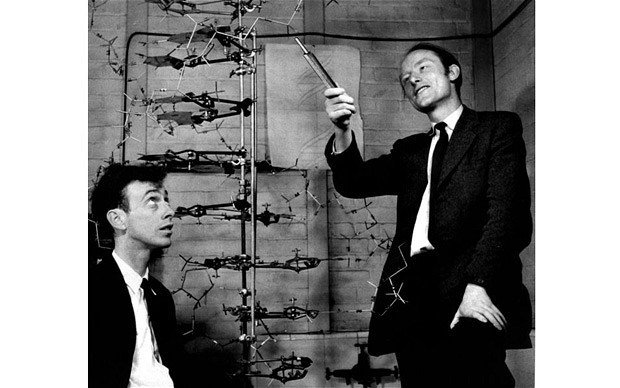DISCLAIMER: please be advised that the post prepared here may contain traces of scientific jargon, therefore it may not be suited for all audience. If you are allergic to scientific terms you should stay away from this page. If you decide to keep reading it's at your own risk.

What is life?
A simple question that requires a complex answer. For centuries we explained the origin of life in an evolutionary framework, in terms of the spontaneous formation of simple organisms from non-living matter.
The original belief was that Earth had generated carbon compounds which gradually gained complexity, eventually forming proteins. Thus, the assumption is that naked lumps of proteins morphed into micellae heralded the origin of life.
The problem is that when most theories about the origin of life were generated, our knowledge of molecular biology was extremely limited. In fact, in the nineteenth-century we used to believe that the protoplasm (the matter that constitutes the cell) could not be divided without destroying its biological functions/metabolism. With the rise of biochemistry we became aware of the chemical complexity of the cell. In particular, we learned that some proteins, called enzymes, could catalyze specific metabolic reactions even outside the cell. Hence, it became evident that the origin of life could not be explained in terms of the origin of individual molecular species. For years much focus was directed at the study of proteins, especially enzymes and their catalytic functions. With the improvements of microscopy techniques, biologists realized the importance of the cell's nucleus, in particular of chromosomes during cell division. Soon it became obvious that the factors of inheritance were tied to the gene and that genes were located on the chromosomes. So it came the realization that not only genes had to be able to replicate themselves, but also they had to control the development and functioning of their environment, the cell. Experiments in biosynthetic pathways suggested that there was a direct link between the gene and the catalytic function of proteins in a one-to-one correspondence, therefore one gene, one protein (today we know it's more complex than that).
Today we know that biosynthetic pathways encompass complex cascades of reactions fueled by the synthesis of several intermediaries. In 1945, Horowitz raised the question on what were the evolutionary advantages to synthesize such intermediaries. He thought that the first organisms to appear on earth were heterotrophic, which means that they required organic nutrients to provide them with metabolic energy. So these molecules must have been originally absorbed directly as nutrients from the environment. But these nutrients would gradually have become more scarce in the environment, so there was an evolutionary advantage for the cells to start synthesizing these molecules themselves. This means that the capacity evolved to synthesize molecules from a precursor, and then a precursor from its precursor and so on. Therefore, what we know today as the first steps in the biosynthetic pathways evolved last. Each new step evolved as a result of genetic mutation, providing new genes for the synthesis of new enzymes.
This shifted the concept of the origin of life, from a strictly protein-driven origin to a more genetic theory of life. Also it became apparent that proteins are more complex than what originally thought, putting together a few amino acids was not enough to impart function to a protein, the order in which these amino acids were assembled was found to be extremely important.
From the work of Watson and Crick we learned a great deal about DNA structure and we immediately learned what are the mechanisms for its self-replication. We also learned that the order in which the DNA constituents purines and pyrimidines were assembled was the code to synthesize specific proteins and that RNA mediated the interactions between DNA and proteins.

In the 1950s we also started to see the first computers and there was much enthusiasm about the new "digital" era. Scientists came up with all sort of theories and it is fascinating to see how the von Neumann's concept of a self-reproducing automaton came close to describe the molecular pillars of a cell. Here there is a list of the 4 key pillars:
- DNA provides the instructions (written in the language of nucleotide sequences) which contain all the information needed to replicate a cell
- DNA polymerase is the duplicator
- Transfer RNA is the translator/adaptor to decode the message in the assembly machine
- The ribosome is the universal assembling machine which morphs raw materials into the tools essential for the functioning of the cell
We haven't even detailed what are all these cogs in the life machinery, but things are obviously very complex. Even the simple concept of "protoplasm" was so complex that is was extremely unlikely to be result of a chance event. For years people have been asking the chicken and egg question: which came first proteins or DNA?

Maybe neither. Most likely, life originated as a self-perpetuating message, a molecule able to self-replicate and to use the surrounding environment to do so. In other words, it was a molecule capable of autocatalytic and eterocatalytic functions. RNA is a molecule that match the description.
In fact, scientists were able to generate in a lab RNA capable of self-replication using surrounding minerals as a catalysts (even if it took weeks to make a single copy of itself). Today we may think of RNA as a mere link between proteins and DNA, but in the primordial earth, RNA might have been the first prototype of life. The gene and the proteins were most likely just an evolutionary by-product. A fortuitous accident that shaped life as we know it today.
Sources:
http://elements.geoscienceworld.org/content/1/3/145
https://www.nature.com/articles/26193
